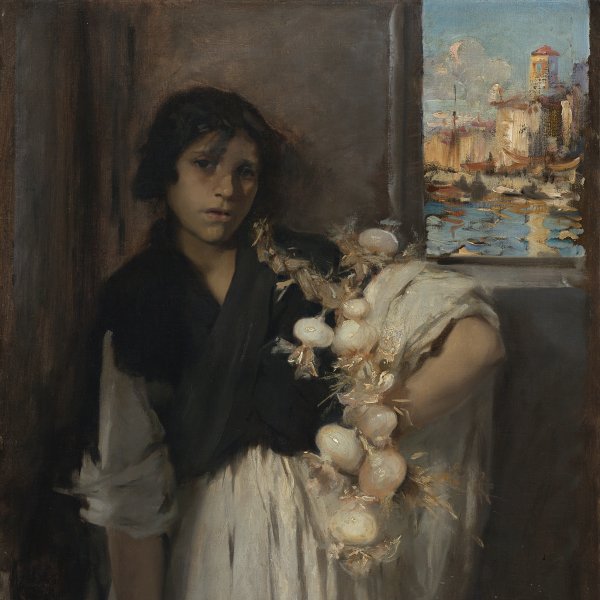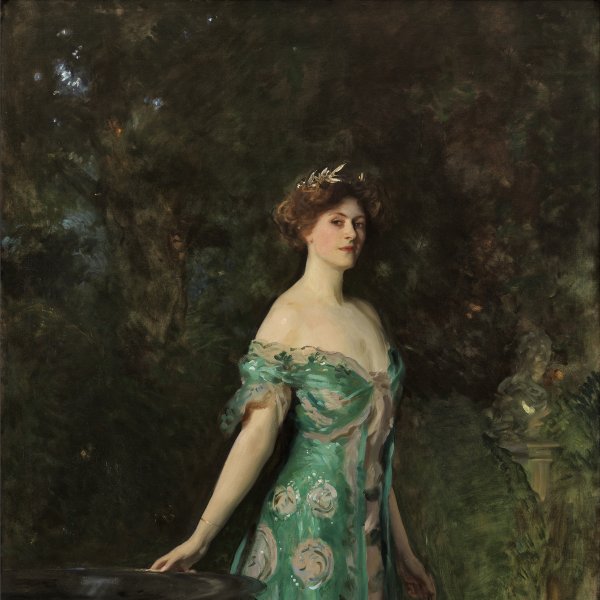John Singer Sargent
Florence, 1856-London, 1925
John Singer Sargent, the most famous society portraitist of the last third of the nineteenth century, was born in Florence to American parents. He received his first art lessons in Rome in 1868 and later at the Accademia delle Belle Arti in Florence. In 1874 he was admitted to the workshop of Carolus-Duran, a famed Paris portraitist, who instilled in him an interest in the palette of Diego Velázquez and the brushwork of Frans Hals. During a trip in 1879 and 1880 which took him to Holland and Spain, among other countries, he observed and copied the work of these two artists. A year later he met James Whistler in Venice.
Sargent made his debut at the Paris Salon in 1877 and his fame as a portraitist quickly grew in the French art world. However, the exhibition of one of his works in 1884, the portrait known as Madame X (New York, The Metropolitan Museum of Art), triggered a huge scandal as a result of which he soon left France to establish himself in London, where he carried on with his work as a portraitist. By the turn of the century, Sargent was acclaimed as the finest portrait painter of his day. He alternated his life in the big city with stays in the United States and summers spent in picturesque parts of southern Europe and the Alps. In these places he began to experiment and paint outdoors in the manner of the painters of the Barbizon School.
During his life Sargent was very prolific, collected art and befriended prominent people of the day, such as Claude Monet, Henry James and Isabella Stewart Gardner. By 1897 he was already a member of the London Royal Academy of Art, the New York National Academy of Design and the French Legion of Honour.
Although he never lived in the United States, his importance on the American art scene was reflected in a large number of commissions. These were not limited to portraits but included various cycles of murals for the city of Boston and Harvard University.
From 1907 onwards Sargent almost completely abandoned the genre of portraiture and developed a greater interest in the watercolour technique and landscape sketches. During the First World War he was commissioned by the British Government War Office to make a series of drawings of the French front. He died in London in 1925.
Sargent made his debut at the Paris Salon in 1877 and his fame as a portraitist quickly grew in the French art world. However, the exhibition of one of his works in 1884, the portrait known as Madame X (New York, The Metropolitan Museum of Art), triggered a huge scandal as a result of which he soon left France to establish himself in London, where he carried on with his work as a portraitist. By the turn of the century, Sargent was acclaimed as the finest portrait painter of his day. He alternated his life in the big city with stays in the United States and summers spent in picturesque parts of southern Europe and the Alps. In these places he began to experiment and paint outdoors in the manner of the painters of the Barbizon School.
During his life Sargent was very prolific, collected art and befriended prominent people of the day, such as Claude Monet, Henry James and Isabella Stewart Gardner. By 1897 he was already a member of the London Royal Academy of Art, the New York National Academy of Design and the French Legion of Honour.
Although he never lived in the United States, his importance on the American art scene was reflected in a large number of commissions. These were not limited to portraits but included various cycles of murals for the city of Boston and Harvard University.
From 1907 onwards Sargent almost completely abandoned the genre of portraiture and developed a greater interest in the watercolour technique and landscape sketches. During the First World War he was commissioned by the British Government War Office to make a series of drawings of the French front. He died in London in 1925.






